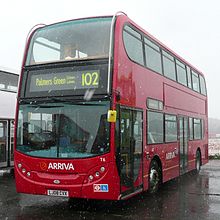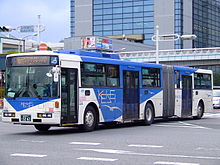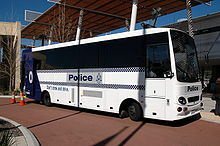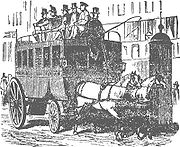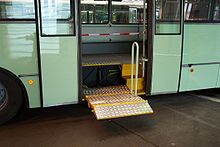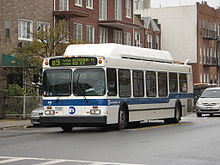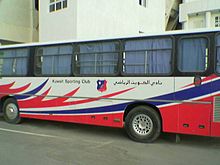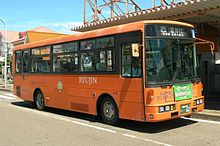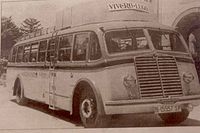- Bus
-
This article is about Road vehicles designed to carry passengers. For longer distance passenger vehicles, see Coach (vehicle). For other uses, see Bus (disambiguation).
A bus (
 /ˈbʌs/; plural "buses" or "busses", /ˈbʌsɨz/, archaically also omnibus, multibus, or autobus) is a road vehicle designed to carry passengers. Buses can have a capacity as high as 300 passengers.[1] The most common type of bus is the single-decker bus, with larger loads carried by double-decker buses and articulated buses, and smaller loads carried by midibuses and minibuses; coaches are used for longer distance services. Bus manufacturing is increasingly globalised, with the same design appearing around the world.
/ˈbʌs/; plural "buses" or "busses", /ˈbʌsɨz/, archaically also omnibus, multibus, or autobus) is a road vehicle designed to carry passengers. Buses can have a capacity as high as 300 passengers.[1] The most common type of bus is the single-decker bus, with larger loads carried by double-decker buses and articulated buses, and smaller loads carried by midibuses and minibuses; coaches are used for longer distance services. Bus manufacturing is increasingly globalised, with the same design appearing around the world.Buses may be used for scheduled bus transport, scheduled coach transport, school transport, private hire, tourism; promotional buses may be used for political campaigns and others are privately operated for a wide range of purposes.
Horse drawn buses were used from 1820, followed by steam buses in the 1830 and electric trolleybuses in 1882. The first buses powered by internal combustion engines were used 1895[citation needed] and this is still the most common power source. Recently there has been growing interest in hybrid electric buses, fuel cell buses, electric buses as well as ones powered by compressed natural gas or bio-diesel.
Contents
Etymology
Bus is an apheresis of the Latin word Omnibus. The latter name is derived from a hatter's shop which was situated in front of one of the first bus stations in Nantes, France in 1823. "Omnes Omnibus" was a pun on the Latin sounding name of that hatter Omnès: omnes meaning "all" and omnibus means "for all" in Latin. Nantes citizen soon gave the nickname of Omnibus to the vehicle.[2] When motorized transport replaced horse-drawn transport starting 1905, a motorized omnibus was called an autobus, a term still used.
Types
Formats include single-decker bus, double-decker bus and articulated bus (or 'bendy-bus') the prevalence of which varies from country to country. bi-articulated buses are also manufactured, and passenger-carrying trailers— either towed behind a conventional bus (a bus trailer), or hauled as a trailer by a truck (a trailer bus). Smaller midibus have a lower capacity and open-top bus are typically used for leisure purposes. In many new fleets, particularly in local transit systems, there is an increasing shift to low-floor buses primarily for easier accessibility. Coaches are designed for longer-distance travel and are typically fitted with individual high-backed reclining seats, seat-belts, toilets, audio-visual entertainment systems and can operate at higher speeds with more capacity for luggage. Coaches may be single- or double-deckers, articulated and often include a separate luggage compartment under the passenger floor. Guided buses are fitted with technology to allow them to run in designated guideways, allowing the controlled alignment at bus stops and less space taken up by guided lanes than conventional roads or bus lanes.
Bus manufacturing may be by a single company (an integral manufacturer), or by one manufacturer's building a bus body over a chassis produced by another manufacturer.
Design
Accessibility
Bus with wheelchair lift extended
Transit buses increasingly use low-floor bus designs and optionally also 'kneeling' air suspension and electrically or hydraulically extended under-floor ramps to provide level access for wheelchair users and people with baby carriages. Prior to more general use of such technology these wheelchair users could only use specialist paratransit mobility buses.
Accessible vehicles also have wider entrances and interior gangways and space for wheelchairs. Interior fittings and destination displays may also be designed to be usable by the visually impaired. Coaches generally use wheelchair lifts instead of low floor designs. In some countries vehicles are required to have these features by disability discrimination laws.
Configuration
Buses were initially configured with an engine in the front and an entrance at the rear. With the transition to one-man operation, many manufacturers moved to mid or rear-engined designs, with a single door at the front, or multiple doors. The move to the low-floor design has all but eliminated the mid-engined design, although some coaches still have mid mounted engines. Front-engined buses still persist for niche markets such as American school buses, some minibuses, and buses in less developed countries, which may be derived from truck chassis, rather than purpose-built bus designs. Most buses have two axles, articulated buses have three.
Guidance
Guided buses are fitted with technology to allow them to run in designated guideways, allowing the controlled alignment at bus stops and less space taken up by guided lanes than conventional roads or bus lanes. Guidance can be mechanical, optical or electromagnetic. Guidance is often, but not exclusively, employed as part of a BRT scheme. Extensions of the guided technology include the Guided Light Transit and Translohr systems, although these are more often termed 'rubber tyred trams' as they have limited or no mobility away from their guideways.
Liveries
Transit buses are normally painted to identify the operator or a route, function or to demarcate low-cost or premium service buses. Bus may be painted onto the vehicle, applied using adhesive vinyl technologies or using decals. Vehicles often also carry bus advertising or part or all of their visible surfaces (as mobile billboard). campaign buses may be decorated with key campaign messages.
Propulsion
The most common power source since the 1920s has been the diesel engine. Early buses, known as trolleybus, were powered by electricity supplied from overhead lines. Nowadays, electric buses often carry their own battery, which is sometimes recharged on stops/stations in order to keep the size of the battery small/lightweight. Currently there is interest in hybrid electric buses, fuel cell buses, electric buses and ones powered by compressed natural gas or bio-diesel. Gyrobuses, which are powered by the momentum stored by a flywheel were tried in the 1940s.
Manufacture
Main article: Bus manufacturingEarly bus manufacturing grew out of carriage coachbuilding, and later out of automobile or truck manufacturers. Early buses were merely a bus body fitted to a truck chassis. This body+chassis approach has continued with modern specialist manufacturers, although there also exist integral designs such as the Leyland National where the two are practically inseparable. Specialist builders also exist and concentrate on building buses for special uses, or modifying standard buses into specialised products.
Integral designs have the advantages that they are have been well tested for strength, stability and so forth, and also are off-the-shelf. But there are, however, two incentives to use the chassis+body model. First it allows the buyer and manufacturer both to shop for the best deal for their needs, rather than having to settle on one fixed design— the buyer can choose the body and the chassis separately. Second it is likely that over the lifetime of a vehicle (in constant service and heavy traffic) that it will get minor damage now and again, and to be able easily to replace a body panel or window etc. can vastly increase its service life and save the cost and inconvenience of removing it from service.[citation needed]
As with the rest of the automotive industry, into the 20th century bus manufacturing increasingly became globalized, with manufacturers producing buses far from their intended market to exploit labour and material cost advantages. As with the cars, new models are often exhibited by manufacturers at prestigious industry shows to gain new orders.[citation needed]
Uses
Public transport
Main article: Public transport bus serviceTransit bus, used on public transport bus services, have utilitarian fittings designed for efficient movement of large numbers of people, and often have multiple doors. coaches are used for longer distance routes. High capacity bus rapid transit services may use the bi-articulated bus or tram style buses such as Wright StreetCar and the Irisbus Civis.
Buses and coach services often operate to a pre-determined published public transport timetable defining the route and the timing, however smaller vehicles may be used on more flexible demand responsive transport services.
Tourism
Buses play a major part in the tourism industry. Tour buses around the world allow tourists to view local attractions or scenery. These are often open-top buses, but can also be by regular bus or coach.
In local sightseeing, City Sightseeing is the largest operator of local tour buses, operating on a franchised basis all over the world. Specialist tour buses are also often owned and operated by safari parks and other theme parks or resorts. Longer distance tours are also carried out by bus, either on a turn up and go basis or through a tour operator, and usually allow disembarkation from the bus to allow touring of sites of interest on foot. These may be day trips or longer excursions incorporating hotel stays. Tour buses will often carry a tour guide, although the driver or a pre-recorded audio commentary may also perform this function. The tour operator may itself be a subsidiary of a bus operating company that operates buses and coaches for other uses, or an independent company that charters buses or coaches. Commuter transport operators may also use their coaches to conduct tours within the target city between the morning and evening commuter transport journey.
Buses and coaches are also a common component of the wider package holiday industry, providing private airport transfers (in addition to general airport buses) and organised tours and day trips for holidaymakers on the package.
Public long distance coach networks are also often used as a low-cost method of travel by students or young people travelling the world. Some companies such as Topdeck Travel were set up to specifically use buses to drive the hippie trail or travel to places like north Africa.
In many tourist or travel destinations, a bus is part of the tourist attraction, such as the North American tourist trolleys, London’s Routemaster heritage routes, or the customised buses of Malta, Asia and the Americas.
Student transport
 U.S. style school bus
U.S. style school bus Main article: Student transport
Main article: Student transportIn some countries, particularly the USA and Canada, buses used to transport school children have evolved in to a specific design with specified mandatory features. These school buses feature things such as the school bus yellow livery and crossing guards. Other countries may mandate the use of seat belts. As a minimum many countries require that a bus carrying students displays a sign, and may also adopt yellow liveries. Student transport often uses older buses cascaded from service use, retro-fitted with more seats and/or seatbelts. Student transport may be operated by local authorities or private contractors. Schools may also own and operate their own buses for other transport needs, such as class field trips, or to transport associated sports, music or other school groups.
Private charter
Due to the costs involved in owning, operating and driving buses and coaches, many bus and coach uses a private hire of vehicles from charter bus companies, either for a day or two, or a longer contract basis, where the charter company provides the vehicles and qualified drivers. Charter bus operators may be completely independent businesses, or charter hire may be a subsidiary business of a public transport operator who might maintain a separate fleet or use surplus buses, coaches, and dual purpose coach seated buses. Many private taxicab companies also operate larger minibus vehicles to cater for group fares. Companies, private groups and social clubs may hire buses or coaches as a cost effective method of transporting a group to an event or site, such as a group meeting, racing event, or organised recreational activity such as a summer camp. Entertainment or event companies may also hire temporary shuttles buses for transport at events such as festivals or conferences. Party buses are used by companies in a similar manner to limousine hire, for luxury private transport to social events or as a touring experience. Sleeper buses are used by bands or other organisations that tour between entertainment venues and require mobile rest and recreation facilities. Some couples hire preserved buses for their wedding transport instead of the traditional car. Buses are often hired for parades or processions. Victory parades are often held for triumphant sports teams, who often tour their home town or city in an open-top bus. Sports teams may also contract out their transport to a team bus, for travel to away games, to a competition or to a final event. These buses are often specially decorated in a livery matching the team colours. Private companies often contract out private shuttle bus services, for transport of their customers or patrons, such as hotels, amusement parks, university campuses or private airport transfer services. This shuttle usage can be as transport between locations, or to and from parking lots. High specification luxury coaches are often chartered by companies for executive or VIP transport. Charter buses may also be used in Tourism and for promotion (See Tourism and Promotion sections)
Private ownership
Many organisations, including the police, not for profit, social or charitable groups with a regular need for group transport may find it practical or cost-effective to own and operate a bus for their own needs. These are often minibuses for practical, tax and driver licensing reasons, although they can also be full size buses. Cadet or scout groups or other youth organizations may also own buses. Specific charities may exist to fund and operate bus transport, usually using specially modified mobility buses or otherwise accessible buses (See Accessibility section). Some use their contributions to buy vehicles, and provide volunteer drivers.
Airport operators make use of special airside airport buses for crew and passenger transport in the secure airside parts of an airport. Some public authorities, police forces and military forces make use of armoured buses where there is a special need to provide increased passenger protection. The United States Secret Service acquired two in 2010 for transporting dignitaries needing special protection.[3] Police departments make use of police buses for a variety of reasons, such as prisoner transport, officer transport, temporary detention facilities and as command and control vehicles. Some fire departments also use a converted bus as a command post,[4] while those in cold climates might retain a bus as a heated shelter at fire scenes.[5] Many are drawn from retired school or service buses.
Promotion
Buses are often used for advertising, political campaigning, public information campaigns, public relations or promotional purposes. These may take the form of temporary charter hire of service buses, or the temporary or permanent conversion and operation of buses, usually of second-hand buses. Extreme examples include converting the bus with displays and decorations or awnings and fittings. Interiors may be fitted out for exhibition or information purposes with special equipment and/or audio visual devices.
Bus advertising takes many forms, often as interior and exterior adverts and all-over advertising liveries. The practice often extends into the exclusive private hire and use of a bus to promote a brand or product, appearing at large public events, or touring busy streets. The bus is sometimes staffed by promotions personnel, giving out free gifts. Campaign buses are often specially decorated for a political campaign or other social awareness information campaign, designed to bring a specific message to different areas, and/or used to transport campaign personnel to local areas/meetings. Exhibition buses are often sent to public events such as fairs and festivals for purposes such as recruitment campaigns, for example by private companies or the armed forces. Complex urban planning proposals may be organised into a mobile exhibition bus for the purposes of public consultation.
Buses around the world
See also: Category:Bus transport by country and List of busesHistorically, the types and features of buses have developed according to local needs. Buses were fitted with technology appropriate to the local climate or passenger needs, such as air conditioning in Asia, or cycle mounts on North American buses. The bus types in use around the world where there was little mass production were often sourced second hand from other countries, such as the Malta bus, and buses in use in Africa. Other countries such as Cuba required novel solutions to import restrictions, with the creation of the “camellos” (camel bus), a specially manufactured trailer bus.
After the Second World War, manufacturers in Europe and the Far East, such as Mercedes-Benz buses and Mitsubishi Fuso expanded into other continents influencing the use of buses previously served by local types. Use of buses around the world has also been influenced by colonial associations or political alliances between countries. Several of the Commonwealth nations followed the British lead and sourced buses from British manufacturers, leading to a prevalence of double-decker buses. Several Eastern Bloc countries adopted trolleybus systems, and their manufacturers such as Trolza exported trolleybuses to other friendly states.[citation needed] In the 1930s Italy designed the world's only triple decker bus for the busy route between Rome and Tivoli that could carry eighty-eight passengers. It was unique not only in being a triple decker but having a separate smoking compartment on the third level.[6]
The buses to be found in countries around the world often reflect the quality of the local road network, with high floor resilient truck based designs prevalent in several less developed countries where buses are subject to tough operating conditions. Population density also has a major impact, where dense urbanisation such as in Japan and the far east has led to the adoption of high capacity long multi-axle buses, often double-deckers, while South America and China are implementing large numbers of articulated buses for bus rapid transit schemes.
Bus expositions
Euro Bus Expo is a trade show, which is held bi-annually at the UK's National Exhibition Centre in Birmingham. As the official show of the Confederation of Passenger Transport, the UK’s trade association for the bus, coach and light rail industry, the three day event offers visitors from Europe and beyond the chance to see and experience, at first hand, the very latest vehicles and product and service innovations right across the industry. The next show will be held in November 2010.[7]
Busworld Kortrijk is the leading bus trade fair in Europe is the Busworld in Kortrijk in Belgium. It is held bi-annually, last time October 2009 and next time October 2011.
History
The first known public bus line (known as a "Carriage" at that time) was launched by Blaise Pascal in 1662 and was quite popular until fares were increased and access from to the service restricted to high society members only by regulation. Services ceased after 15 years[2][8] and no further such services were known until the 1820s.[citation needed] Horse buses operated in many cities during the later part of the 1800s and early 1900s with one company in London operating 220 horse-buses by 1880. The last horse bus in London stopped operation in 1914.[9] Early horse-drawn buses were a combination of a hackney carriage and a stagecoach.[citation needed]
From the 1830s steam powered buses existed. In parallel to the development of the bus, was the invention of the electric trolleybus, typically fed through trolley poles by overhead wires, which actually preceded, and in many urban areas outnumbered, the conventional engine powered bus[citation needed]. The first internal combustion engine buses were developed along with the automobile. After the first engine powered bus of 1895[citation needed].
The Yellow Coach Manufacturing Company which rapidly became a major manufacturer of buses was founded in Chicago in 1923 by John D. Hertz. General Motors purchased a majority stake in 1925 and changed its name to the Yellow Truck & Coach Manufacturing Company. They then purchased the balance of the shares in 1943 to form the GM Truck & Coach Division.
Models expanded in the 20th century, leading to the widespread introduction of the contemporary recognizable form of full size buses from the 1950s.
One of the most unusual buses ever built was a prop for Paramount Productions in 1935 for a movie set.[10]
The Montgomery Bus Boycott which opposed the city's policy of racial segregation on its public transit system started on 1 December 1955, when Rosa Parks, an African American woman, was arrested for refusing to surrender her seat to a white person in Montgomery, Alabama, USA. It ended on 20 December 1956 with a United States Supreme Court decision that the laws requiring segregated buses were unconstitutional.[11] Many historically significant figures of the civil rights movement were involved in the boycott, including Reverend Martin Luther King, Jr. and Ralph Abernathy.
Use of retired buses
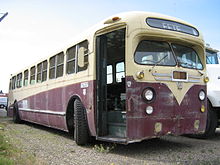 Retired GM bus
Retired GM bus
Most public or private buses and coaches, once they have reached the end of their service with one or more operators, are sent to the wrecking yard for breaking up for scrap and spare parts. Some buses, while not economical to keep running as service buses, are often converted in some way for use by the operator, or another user, for purposes other than revenue earning transport. Much like old cars and trucks, buses often pass through a dealership where they can be bought for a price or at auction.
Bus operators will often find it economical to convert retired buses to use as permanent training buses for driver training, rather than taking a regular service bus out of use. Some large operators have in the past also converted retired buses into tow bus vehicles, to act as tow trucks. With the outsourcing of maintenance staff and facilities, the increase in company health and safety regulations, and the increasing curb weights of buses, many operators now contract their towing needs to a professional vehicle recovery company.
Many retired buses have been converted to static or mobile cafés, often using historic buses as a tourist attraction. Food is also provided from a catering bus, in which a bus is converted into a mobile canteen and break room. These are commonly seen at external filming locations to feed the cast and crew, and at other large events to feed staff. Some organisations adapt and operate playbuses or learning buses to provide a playground or learning environments to children who might not have access to proper play areas. An ex-London Routemaster bus has been converted to a mobile theatre and catwalk fashion show.[12]
Some buses meet a destructive end by being entered in banger races or at demolition derbys.
Many old retired buses have also been converted into mobile holiday homes and campers.
Bus preservation
Rather than being scrapped or converted for other uses, sometimes retired buses are saved for preservation. This can be done by individuals, volunteer preservation groups or charitable trusts, museums, or sometimes by the operators themselves as part of a heritage fleet. These buses often need to undergo a degree of vehicle restoration to restore them to their original condition, and will have their livery and other details such as internal notices and rollsigns restored to be authentic to a specific time in the bus's actual history. Some buses that undergo preservation are rescued from a state of great disrepair, but others enter preservation with very little wrong with them. As with other historic vehicles, many preserved buses either in a working or static state form part of the collections of transport museums. Working buses will often be exhibited at rallies and events, and they are also used as charter buses. While many preserved buses are quite old or even vintage, in some cases relatively new examples of a bus type can enter restoration. In-service examples are still in use by other operators. This often happens when a change in design or operating practice, such as the switch to one person operation or low floor technology, renders some buses redundant while still relatively new.
See also
- Bicycle carrier (bus mounted bike racks)
- Bus spotting
- Coach (used for long distance travel)
- Dollar van
- List of buses
- List of fictional buses
- Trackless train
- Tram
References
- ^ "China's longest bus unveiled in Shanghai". Jongo.com. 15 March 2007. http://news.jongo.com/articles/07/0315/9180/OTE4MAmXAYhbF0.html.
- ^ a b "Histoire générale des transports". French transportations Museum Website. http://www.amtuir.org/03_htu_generale/htu_1_avant_1870/htu_1.htm. Retrieved 16 September 2010. (French)
- ^ Robert Farley (25 August 2011). "Obama’s Canadian-American Bus". FactCheck. http://www.factcheck.org/2011/08/obamas-canadian-american-bus/. Retrieved 17 October 2011.
- ^ "Chesapeake Fire Department". Cityofchesapeake.net. 1998-05-01. http://cityofchesapeake.net/services/depart/fire/bus.shtml. Retrieved 2010-10-12.
- ^ City of Winnipeg Corporate Web Services. "Winnipeg Fire Department". Winnipeg.ca. http://www.winnipeg.ca/fps/Services/Operations/MIRV.stm. Retrieved 2010-10-12.
- ^ "Three Decker Auto Bus Carries 88 Persons" Popular Mechanics, August 1932
- ^ "Euro Bus Expo : Welcome to the European coach & bus industry exhibition". Eurobusxpo.com. http://www.eurobusxpo.com. Retrieved 2009-05-30.
- ^ "Le temps de révolutions". Herodote.net. http://www.herodote.net/histoire/evenement.php?jour=18260810. Retrieved 16 September 2010. (French) Retrieved 13 June 2008.
- ^ "Riding on a knifeboard". London Museum. http://www.museumoflondon.org.uk/postcodes/places/SE15.html. "Thomas Tilling started his bus service in the 1840s. By 1901 he had a total of 220 horse-drawn buses... The last recorded horse omnibus in London was a Tilling bus. It ran its last journey between Peckham and Honor Oak Tavern on 4 August 1914."
- ^ "Streamline Bus Is Like Dirigible On Wheels" Popular Mechanics, April 1935
- ^ "Montgomery Bus Boycott". Civil Rights Movement Veterans. http://www.crmvet.org/tim/timhis55.htm#1955mbb.
- ^ Event preview: Fashion Bus On The Square, London The Guardian, 16 August 2008
 This article incorporates text from a publication now in the public domain: Chisholm, Hugh, ed (1911). Encyclopædia Britannica (11th ed.). Cambridge University Press.
This article incorporates text from a publication now in the public domain: Chisholm, Hugh, ed (1911). Encyclopædia Britannica (11th ed.). Cambridge University Press.
External links
Buses List of busesConfiguration Articulated bus · Bi-articulated bus · Coach · Double-decker bus · High-floor · Lowbridge double-deck bus · Low-floor bus · Midibus · Minibus · Multi-axle bus · Open-top bus · Single-decker bus · Trailer bus · Truck busSpecial uses Advert bus · Airport bus · Armoured bus · Battle bus · Campaign bus · Party bus · Police bus · School bus · Sleeper bus · Transit bus · Training bus · Tour bus · Trolley-replica busTechnologies Manufacturing Bus manufacturing · Bus manufacturersCategory: BusesBus rapid transit Sub-articles Vehicles Systems See also Categories:- Bus transport
- Buses
Wikimedia Foundation. 2010.

